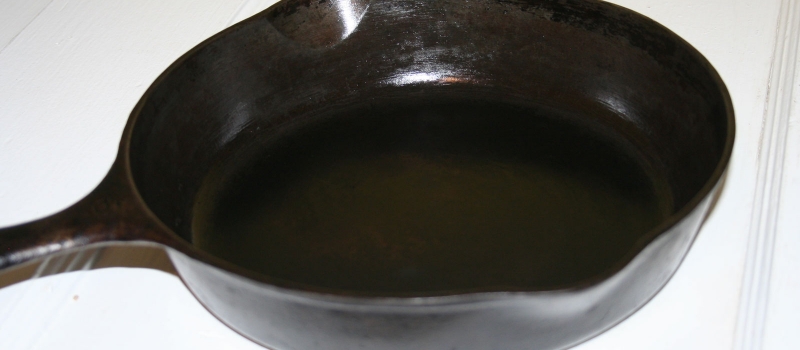
was gifted two cast iron pans over a year ago. They weren’t new, they were salvaged, but the gift-giver knew I’d been wanting cast iron and also knew I wouldn’t mind the challenge of restoring them to their old glory!
But y’all, these things were old…I’m talking rusty, crusty OLD! And, quite frankly, they were daunting! I did some quick research on restoring these neglected gems, but I didn’t want to do it wrong, or ruin them…or fail! So they sat, untouched, taking up valuable kitchen real-estate, for months!
What a waste!
This past summer we went on a camping trip with some friends to West Glacier National Park (if you’ve never been to Glacier, pack your bags right now and go…don’t think twice, no hesitating, no looking back, just GO! It’s spectacular!).
Our friends brought along a giant cast iron skillet and (due to fire bans and the need to cook on propane stoves) we did the majority of our cooking in that one giant, cast iron pan, giving me a crash course on cooking and seasoning cast iron.
I have come to realize that the majority of our uncertainties or fears concerning anything new is the unknown. It’s new and we’re newbies, and that’s intimidating! We can make up reasons why it’s not right for us, but I’ve come to realize that our own illusions are much more intimidating or harder than reality!
Once home from Glacier, I unearthed my pans, stripped them down with good ole stainless steel and elbow grease. Then, seasoned them numerous times with flax-seed oil. (I continue to season them with the lard I had rendered from last winters pig).
Let me tell ya, when properly seasoned, cooking with cast iron is better than cooking on a non-stick pan any day! My fried eggs slide right out without breaking a yolk!
It has to be mentioned that the non-stick coating in most “non-stick cookware” contains PFCs (perfluorocarbons), a chemical that’s linked to liver damage, cancer, developmental problems and more. The food you cook in those pans absorbs those toxins, and you also breathe in the harmful fumes while cooking…not OK in my book.
But, with cast iron, absorption is good! What you cook will absorb iron (something many Americans, especially women, are deficient in today), fortifying your food and benefiting your body. Food cooked in cast iron (especially tomatoes) can increase in iron content by up to 20 times! Truth!
My desire for more cast iron cookware is growing by the day. My MIL has an awesome cast iron griddle I’ve been coveting borrowing from time to time. And I’ve been watching for the sale prices of this killer set on Amazon…wink-wink, nudge-nudge, subtle aren’t I Hubs? Christmas is just around the corner!
Bottom line is, with the improvements we’ve made in our food choices over the past 10 years, it was time to improve our cookware. If you’re in the same boat, but updating your whole arsenal of cookware is out of the question, then consider shopping local thrift stores, asking relatives if they have any tucked away in storage, or start small and build your collection over time (this pan doubles as a Dutch oven/lid and pan! A great two-fer!).
Between Christmas, birthdays, anniversaries and Presidents Day, you could have your collection built in less than a year! (What? You don’t give gifts on all major and minor holidays?)
*If you’re ready to start using cast iron, hop on over to our Seasoning Cast Iron post for a tutorial on seasoning cast iron (and why it’s important to strip and re-season newly purchased cast iron).



Ok so I have a set of cast iron pots but they are painted on the outside. Does that make a difference? I’m looking forward the seasoning post!.. everytime I make eggs in them they stick like crazy!
Lauren, are they painted? Or enamel coated? That makes a difference! If enamel, use them! And two quick tips…never use soap on your cast iron when cleaning and use liberal amounts of fat before and after cooking in your pans. I’ll try to get that seasoning post written ASAP!
I’m thinking enamel coated. They are dutch ovens from Europe that I love 🙂 and sure I will even more when I can make eggs in them! Thanks for the tips
Enamel is perfectly fine! Stay tuned for the tutorial!
Looking forward to the seasoning post!
First… last winter’s pig?!!
What I really wanted to say (before my finger shot out and accidentally hit the Post Comment button) is that I love learning all about cast iron skillets! And your writing style is wonderful and funny! I will be reading every word you publish! Truth!
You read that right, Betsy! Last winter’s pig…stay tuned for a post about that from Jason. We helped butcher the pig, saved the extra fat, and I rendered it to use for cooking and seasoning my cast iron! It’s such a healthy fat that’s gotten a bad wrap.